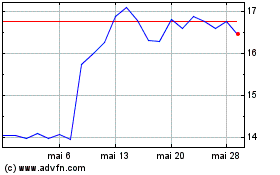Teva Begins Trading on the New York Stock Exchange
30 Mai 2012 - 10:45PM
Business Wire
Dr. Phillip Frost, Chairman of the Board of Teva Pharmaceutical
Industries Ltd. (NYSE: TEVA), and Dr. Jeremy Levin, the Company’s
President and CEO, along with a group of employees representing
Teva’s businesses around the world, rang the Opening Bell at the
New York Stock Exchange to celebrate the Company’s transfer to the
NYSE. The Company’s American Depositary Shares began trading this
morning on the NYSE under its existing ticker symbol “TEVA.”
“We are pleased to partner with the NYSE and begin using their
state of the art trading platform and market research,” stated Dr.
Phillip Frost, Chairman of the Board of Directors of Teva. “We are
joining a network of true innovators and leaders listed on the
NYSE.”
“Teva is a global pharmaceutical company and a leader in their
industry with a dedication to their patients,” said Diederik
Zandstra, Head of International Listings, NYSE Euronext. “We are
proud that Teva has chosen to transfer to the NYSE and recognizes
the value of our global community, market structure and technology.
We look forward to our partnership with Teva and its
shareholders."
About Teva
Teva Pharmaceutical Industries Ltd. (NYSE: TEVA) is a leading
global pharmaceutical company, committed to increasing access to
high-quality healthcare by developing, producing and marketing
affordable generic drugs as well as innovative and specialty
pharmaceuticals and active pharmaceutical ingredients.
Headquartered in Israel, Teva is the world's leading generic drug
maker, with a global product portfolio of more than 1,300 molecules
and a direct presence in about 60 countries. Teva's branded
businesses focus on CNS, oncology, pain, respiratory and women's
health therapeutic areas as well as biologics. Teva currently
employs approximately 46,000 people around the world and reached
$18.3 billion in net revenues in 2011.
Teva’s Safe Harbor Statement under the U.S. Private
Securities Litigation Reform Act of 1995:
This release contains forward-looking statements, which express
the current beliefs and expectations of management. Such statements
are based on management’s current beliefs and expectations and
involve a number of known and unknown risks and uncertainties that
could cause our future results, performance or achievements to
differ significantly from the results, performance or achievements
expressed or implied by such forward-looking statements. Important
factors that could cause or contribute to such differences include
risks relating to: our ability to develop and commercialize
additional pharmaceutical products, competition for our innovative
products, especially Copaxone® (including competition from
innovative orally-administered alternatives, as well as from
potential generic equivalents), competition for our generic
products (including from other pharmaceutical companies and as a
result of increased governmental pricing pressures), competition
for our specialty pharmaceutical businesses, our ability to achieve
expected results through our innovative R&D efforts, the
effectiveness of our patents and other protections for innovative
products, decreasing opportunities to obtain U.S. market
exclusivity for significant new generic products, our ability to
identify, consummate and successfully integrate acquisitions
(including the acquisition of Cephalon), the effects of increased
leverage as a result of the acquisition of Cephalon, the extent to
which any manufacturing or quality control problems damage our
reputation for high quality production and require costly
remediation, our potential exposure to product liability claims to
the extent not covered by insurance, increased government scrutiny
in both the U.S. and Europe of our agreements with brand companies,
potential liability for sales of generic products prior to a final
resolution of outstanding patent litigation, including that
relating to the generic version of Protonix®, our exposure to
currency fluctuations and restrictions as well as credit risks, the
effects of reforms in healthcare regulation and pharmaceutical
pricing and reimbursement, any failures to comply with complex
Medicare and Medicaid reporting and payment obligations,
governmental investigations into sales and marketing practices
(particularly for our specialty pharmaceutical products),
uncertainties surrounding the legislative and regulatory pathway
for the registration and approval of biotechnology-based products,
adverse effects of political or economical instability, major
hostilities or acts of terrorism on our significant worldwide
operations, interruptions in our supply chain or problems with our
information technology systems that adversely affect our complex
manufacturing processes, any failure to retain key personnel
(including Cephalon employees) or to attract additional executive
and managerial talent, the impact of continuing consolidation of
our distributors and customers, variations in patent laws that may
adversely affect our ability to manufacture our products in the
most efficient manner, potentially significant impairments of
intangible assets and goodwill, potential increases in tax
liabilities, the termination or expiration of governmental programs
or tax benefits, environmental risks and other factors that are
discussed in our Annual Report on Form 20-F for the year ended
December 31, 2011 and in our other filings with the U.S. Securities
and Exchange Commission.
Teva Pharmaceutical Indu... (NYSE:TEVA)
Graphique Historique de l'Action
De Juin 2024 à Juil 2024

Teva Pharmaceutical Indu... (NYSE:TEVA)
Graphique Historique de l'Action
De Juil 2023 à Juil 2024
